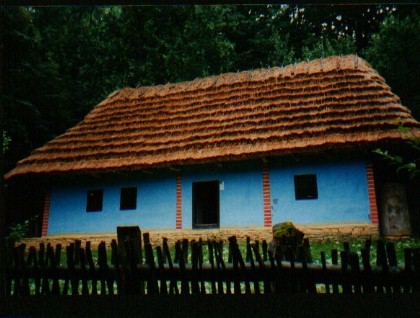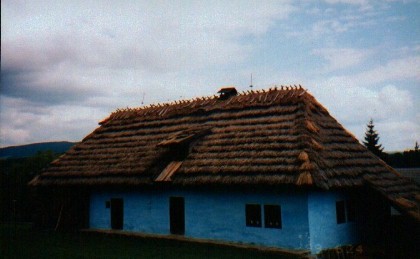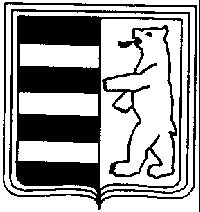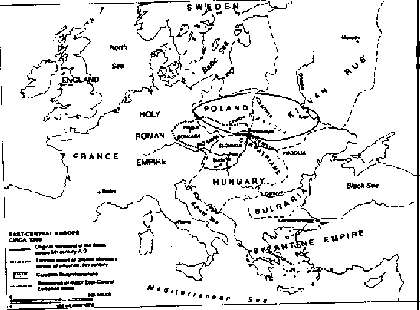Duchnovyc labored
for the benefit of many Rusyn people in the Carpathians. He envisioned
a united Subcarpathian nation, which he was trying to uplift — even the
lowest levels of culture. He has come to be hailed as the “national awakener”
of the Carpatho-Rusyn people.
Dobrjans’kyj was a
member of the Hungarian parliament and Austrian government who between
1849 and 1865 attempted to create a distinct Rusyn territorial entity
within the Hapsburg Empire. He formulated a political program calling
for the unity of Rusyns in Hungary with their brethren north of the mountains
in Galicia. He authored several petitions and led a delegation of Rusyns
from Hungary who met with Emperor Franz Joseph in April 1849.
An imperial decree
from Vienna in 1848-49 introduced the principle of the equality of nationalities.
Rusyn was introduced as an official language besides German and Hungarian
in the five counties where they were the predominant minority.
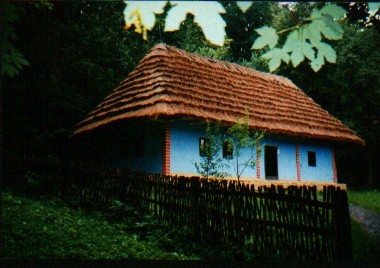
These changes were
shortlived. In September 1850, all civil districts were abolished. Rusyns
were replaced by Magyars and all reforms were eventually nullified. The
Hungarians wanted its citizens to form a single nation—the Magyar nation.
In the late 1860’s the Austro-Hungarian Dual Monarchy came into being.
This meant that the Hungarian Kingdom would be governed by its own laws,
which came out of the parliament in Budapest. Magyar rulers would now
be able to dictate relationships with national minorities, with no interference
from Vienna. Carpatho-Rusyn national revival was stopped dead in its tracks.
Hungary’s primary goal was to maintain as much independence as possible
from the government in Vienna and to consolidate its strength by increasing
the number of Magyars through assimilation of the national minorities.
Law XLIV of 1868—the so called “equality of rights of the nationalities
—was put into practice.
No organization representing
a national minority could legally exist, because this law recognized only
one nation, the Magyar nation. Magyar replaced Rusyn in the schools, which
were then expected to produce patriotic Hungarians steeped in Magyar culture.
Even the churches were affected. Church records which heretofore had been
written in Rusyn by the priest now had to be written in Hungarian. The
Rusyn populace for the most part came to despise its Hungarian masters.
The Rusyns were losing
not only their language but their livelihood as well. Since agriculture
was considered one of the only honorable professions among the Rusyns,
land was passed on to each child who in turn passed it on to their children.
This resulted in smaller and smaller plots of land, which eventually were
too small to sustain the family.
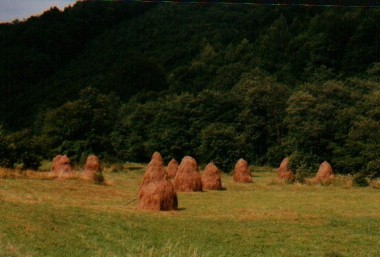
Drying
hay in the Carpathians
The lack of land, low productivity,
and poor methods of cultivation resulted in poverty and semi starvation
of the population. All the great estates were in Magyar hands. The diet
of an average Rusyn consisted mostly of corn or oats, potatoes, mushrooms,
and cabbage. Fat and meat were rarities. (My father has told me of conversations
as a young boy with parishioners who immigrated from Austro-Hungary and
said that the only meat they saw or ate during the year was on the great
feast of Easter.) As a result, health was poor. Tuberculosis, typhus,
cholera, smallpox, throat infections, and other types of common infections
were rampant. One has only to look at the death records from the villages
in which my ancestors lived. Page after page is filled with the names
of people who were wiped out by cholera — it took the young and old. Too
many of my relatives died in infancy or childhood. This was the norm.
A family typically lived in a one room house, or two families lived in
the same house in adjoining rooms. If they had animals, these lived in
the family house in an adjoining room as well.
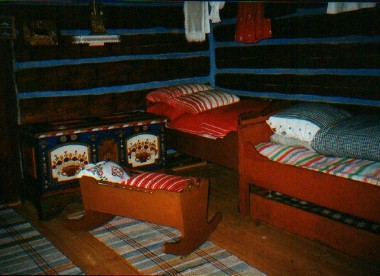
(Here and next photo:)
Inside a typical Rusyn house, Presov
region
The situation seemed
hopeless — the only escape was emigration. From 1880 until World War I,
approximately 500,000 Rusyns (my grandparents and other relatives included)
left the country to escape both the poverty and Magyarization, although
a few thousand had started moving to the Backa region (Vojvodina in present-day
Yugoslavia) in the southern part of the Hungarian kingdom, where Rusyn
colonists had arrived as free individuals as early as 1745. Most left
for the industrial regions of the northeastern United States or Canada.
At the beginning of World War I, Rusyns lacked an educated upper or middle
class and thus were not politically active.
In their new homes,
an aboutface occurred. World War I prevented a further exodus of Rusyns,
many of whom were forced to serve in the Imperial Austro-Hungarian army
where they died or were wounded on the eastern front against Russia or
in northeastern Italy. In the Lemko region during 1914-15, Austrian officials
suspected Lemko Rusyns of treason and deported nearly 6,000 to concentration
camps, especially to the one at Talerhof (Magocsi, “Carpatho-Rusyns: 4”).
At the end of 1918,
a group of American Rusyns under their leader Gregory Zatkovych, a Rusyn-born
Pittsburgh lawyer, met with Tomas Masaryk, the future president of Czechoslovakia,
to discuss the possibility of including an autonomous Ruthenia in the
future Czechoslovakia. In talks, autonomy was guaranteed to the Ruthenian
leaders. Boundaries satisfactory to both were finalized. An agreement
was signed in which the autonomous Ruthenia would include all Hungarian
counties or the parts which were inhabited by Ruthenians. This territory
would have its own governor and administration.
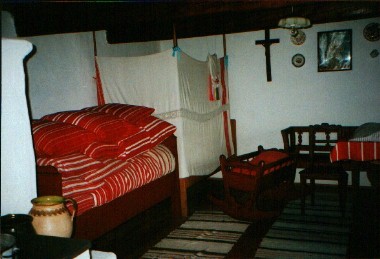
In Hungary, the Ruthenians
and Magyars were also attempting to solve the problem. On December 21,
1918, Law X, “Rus’ka Krajina” (Rusyn State), recognized them as a separate
nationality and gave them the right of self-government in administrative,
judicial, educational, and religious affairs in their territory. Ruthenia
would also have its own national assembly as well as adequate representation
in the Hungarian government.
During the ensuing
months of 1918 and 1919, various Rusyn leaders, including Rev. Emiljan
Nevyc’kyj, Dr. Anton’j Beskyd, and their delegates, met throughout Galicia
and the Presov Region (present-day northeastern Slovakia). They wanted
Lemko Rusyn lands in Galicia and those south of the Carpathians to be
united with Czechoslovakia. On May 8,1919, two hundred Rusyn delegates
met in Uzhorod to form the Central Rusyn National Council. They endorsed
the decree of the American Rusyn Council to unite with Czechoslovakia
on the basis of full autonomy. The results of subsequent sessions undermined
the position of Rusyns in the Presov Region. In the end, the Galician
Lemkos were left to be annexed by Poland. The Uzhorod Council declared
that the borders of the new Rusyn state would be resolved in negotiations
with the Czechoslovak government, and Rusyn leaders in America and Europe
declared that Rusyns in the Presov Regions (northern Spis, Saris, and
Zemplyn counties) be part of an autonomous Rusyn state; but the fact is
that they were placed under Slovak administration. On September 10, 1919,
the Treaty of St. Germain-en-Laye was recognized. Ruthenia was given an
official name Subcarpathian Ruthenia (Podkarpatska Rus’). It would become
an inseparable part of the republic and was promised
the fullest autonomy compatible with the unity of the Czechoslovak state
(Magocsi, Rusyns of Slovakia 67—69).
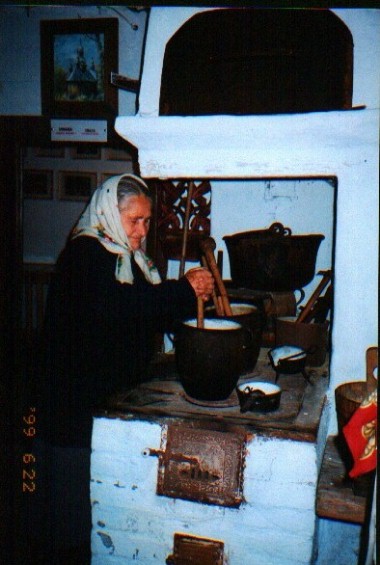
Lemko
house, Poland
What transpired was
that for the first time the Presov Region Rusyns were separated administratively
from their brethren further east. After 1919, Rusyns in Czechoslovakia
did have a province of their own—Subcarpathian Rus’—but the Presov Region
was left under Slovak administration. The Rusyns in the new province had
their own governor and elected representatives in both houses of the national
parliament in Prague; they were considered one of the three state peoples
of Czechoslovakia. They did not, however, receive the political autonomy
they were promised. One hundred thousand Rusyns in the Presov area were
given only the status of a national minority within Slovakia.
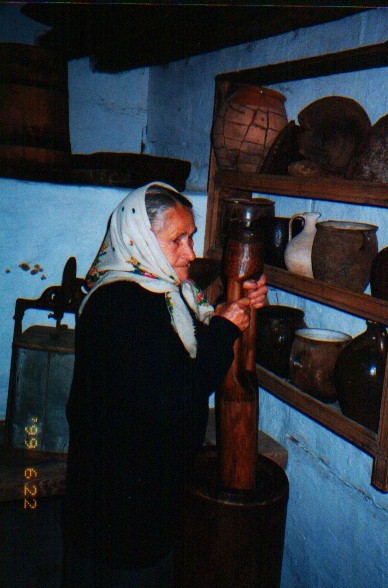
In time, the League
of Nations started receiving petitions that the Czech government was not
living up to its treaty provisions and in many cases the Rusyn population
was being Czechized or Slovakized. Subcarpathian Rus’ functioned from
1919 to 1938 with a Rusyn governor and a limited degree of autonomy. When
Czechoslovakia was betrayed by its allies at the Munich Pact and transferred
into a federal state in October of 1938, Subcarpathian Rus’ received full
governing status. Autonomy, however, lasted a mere six months until March
15, 1939, when Germany destroyed what remained of Czechoslovakia and Hungary.
The Lemko Rusyns found themselves under Nazi occupation after Poland was
destroyed in September 1939 and the Lemko Region was annexed to Hitler’s
Third Reich. In the spring of 1941, Vojvodina, with its Carpatho-Rusyns,
was annexed to Hungary. Thus, during World War II, Carpatho-Rusyn lands
were ruled either by Nazi Germany or its allies, Hungary and Slovakia.
During the course
of the war, the Allied Powers agreed that Subcarpathian Rus’ should again
be a part of a restored Czech state. The Presov Region would remain with
Czechoslovakia, the Lemko Region would be part of a restored Poland, and
the Vojvodina would be a Serbian republic within Yugoslavia. However,
the Soviets prepared for the annexation of Subcarpathian Ruthenia. In
June of 1945, a provisional Czech parliament
(without Carpatho-Rusyn representation) ceded Subcarpathian Rus’ to the
Soviet Union, where it became another oblast of the Soviet Ukraine. This
situation lasted until the fall of Communism and Soviet rule in 1989-91.
As people in this part of Europe tell it, they have lived in at least
five different countries but have never left their homes.
Government official
(in Slovak):
We are interested
in Rusyns and we are
willing to support you. But you must finally
decide if you are Ukrainians or Slovaks.
|
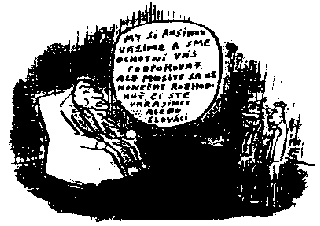
Satirical
work of Fedor Vico,
Rusyn
cartoonist and woodcutter
|
During 1945-46 there
were approximately 180,000 Lemko Rusyns in Poland. Two thirds were encouraged
to immigrate “voluntarily” to Soviet Ukraine. In the spring and summer
of 1947 those who remained were driven from their homes by Polish security
troops in what was known as Akcja Visla— The Vistula Operation. They were
forcibly deported by the Polish government to live in the former German
lands of western and northern postwar Poland because they had been accused
of aiding the Ukrainian Insurgent Army (“Nation Building,” 197—209). In
the border regions, many Rusyn villages were destroyed — plowed under
— while others were taken over by Polish settlers. By late l950, Rusyns
began to return illegally to their native mountain villages, and by the
1980’s approximately 10,000 did succeed in reestablishing new households
or in buying back their old houses, although some were blocked by the
Polish government. The Rusyns in Slovakia fared no better, undergoing
intense Ukrainization and Slovakization brainwashing by the Communist-controlled
government.
With the fall of Communism,
a reawakening of the Rusyn community throughout its former ancestral lands
has been occurring. Carpatho-Rusyns in Transcarpathia (former Subcarpathian
Rus’) have called for a return to their historic status as an autonomous
land.
Rusyn societies have
been established to promote Rusyn culture in Slovakia, Germany, Yugoslavia,
Transcarpathia, Poland, the United States, and Canada. The Rusyn language
in Slovakia has been codified since 1995, while it has always been recognized
in Yugoslavia. There is now an active Rusyn press in those countries that
have a substantial Rusyn population (the Rusyn press in Yugoslavia has
been active since the 1920’s); Rusyn festivals of culture, including poetry
and literary festivals, are now widely held throughout eastern Europe.
The Chepa prize (donated by a Toronto Rusyn businessman) is given yearly
for the best example of Rusyn literature. People in the West can now purchase
Rusyn wood carvings, pottery, embroidery, and paintings.
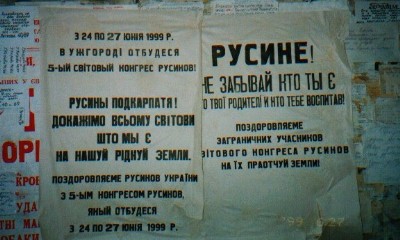
The World Congress of Rusyns met for
the first time on Rusyn soil in 1999 in Uzhorod. The Ukrainian government
has been the only one which refuses to recognize the Rusyn people, yet
the largest minority population in Transcarpathia is the Rusyns. Many
groups are working towards the goal of having the Rusyns recognized as
a minority, including the United Nations and the Unrecognized Nations
and Peoples Organization.
As Petrov so eloquently
states:
The Carpatho-Rusyns have managed
during centuries of oppressions and suffering to preserve their Rus’
soul, Rus’ customs, Rus’ language, and Rus’ name right down to the
twentieth century. A truly just reward for these heroes should not
only be an ardent and enthusiastic concern for them and their welfare,
but also an effort to study these heroes past and to proclaim it to
the whole world. (Petrov 9)
The Rusyns still
face an uphill battle. Many have had to leave their villages in search
of work. One finds only old people in many of them. The church conflict
created by the Soviets between the Orthodox and Greek Catholics may not
heal for years, if ever. The Soviets confiscated the Greek Catholic churches
and designated them as Russian Orthodox. After the fall of Communism,
the Greek Catholics requested that their property be returned. This has
not always happened. As a minority people, they are still persecuted by
much of the populace for who they are — it doesn't matter in which country
they now live. They are still called “shalenij Rusnaci ”— the mad Rusyns
— in reference to their lack of an education during the 19th century.
Racism in Poland, Slovakia, and Ukraine towards Rusyns is still present.
It doesn't bode well for these nations that Rusyns from America and Canada
are now returning to find out about their ancestors and to connect with
the homeland. In most cases, they are better off financially
than the local populace. They debunk
the stereotype of the dumb Rusyn.
COPYRIGHT PAUL ROBERT MAGOCSI
1993. USED WITH PERMISSION.
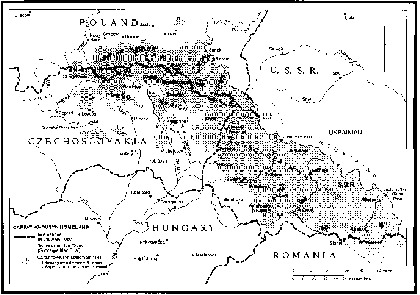
Carpatho-Rusyn
homeland
During the summer
of 1999, I had the opportunity to go on a Rusyn Heritage tour to Poland,
Slovakia, and the Transcarpathian region. We saw firsthand examples of
oppression with visits to a monument commemorating what happened at Talerhof
as well as examples of the Akcja Visla operation throughout Lemko territory.
We learned how hard it is to be a Rusyn in Transcarpathia. However, we
also saw examples of Rusyn revitalization such as the opportunity to sing
Rusyn folk songs with the Lemko Rusyn poet Petro Trokhanovskyi and his
children, to see performances by such outstanding Rusyn groups as Zakarpatskyj
Narodnyj Choir in Uzhorod, and to attend the Rusyn Festival of Culture
and Sport in Medzilaborce.
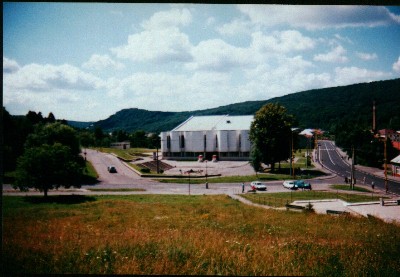
Andy Warhol
Museum in the city Medzilaborce
Medzilaborce is home to the Andy Warhol
Museum. Andy Warhol, nee Varhola, was a Rusyn whose parents came from
the village of Mykova. The museum was established as a memorial to him
and his family. Mykova doesn't look as if it has changed since Warhol’s
parents immigrated to the United States. We saw and were able to purchase
examples of Rusyn craftsmanship. I had not been aware of the Rusyns’ outstanding
artistic talents in woodcarving, pysanky (dyed eggs covered with beeswax
designs), and embroidery. I felt at home on the tour; in a sense I was
at home. I was very proud of my people for their courage and strength
in enduring so much oppression throughout the centuries, proud that so
many had had the presence of mind to leave the “old country” for a better
life. As Karen van Kumes stated so succinctly in an editorial in the August
12-24,1999, edition of The Prague Post, “A government may strip you of
your citizenship but never of your nationality.”
|
Ja
Rusyn byl,
Jesm'y budu,
Ja rodylsja Rusynom,
Cestnyj moj rod ne zabudu
Ostanus’ jeho synom!
|
|
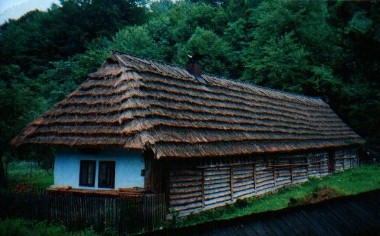
Typical house in Carpathian
Mountains
|
